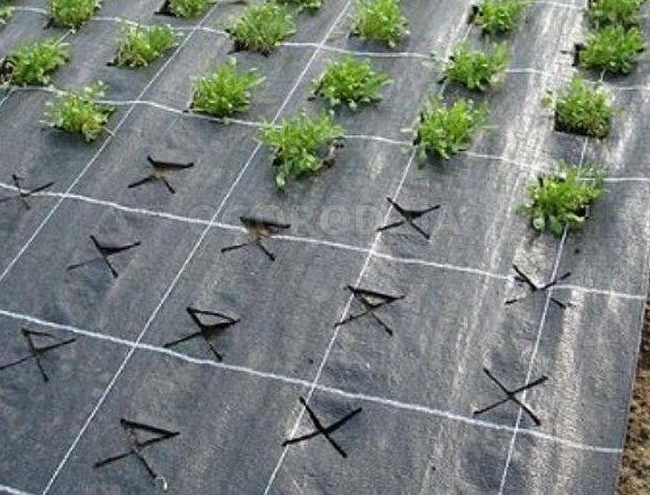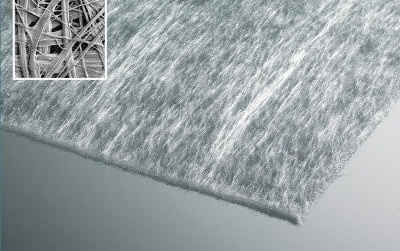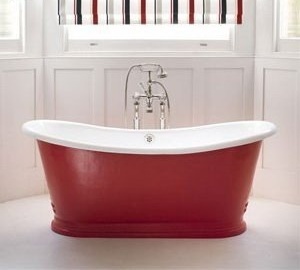Geotextiles: what is and what to choose depending on the type of work
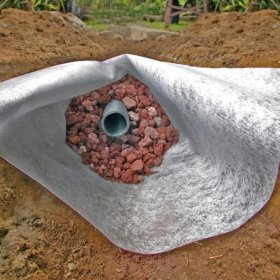
Modern building technologies are developing rapidly, manufacturers in the struggle for the client invent innovative materials with desired properties that allow to achieve excellent results at every stage of construction. Strong, durable, weatherproof - these are the qualities they have. One of these latest inventions, which successfully solves a number of construction tasks, has become geotextiles. He combined naturalness and manufacturability, having earned excellent reviews from experts.
Content
What is geotextile, its application
Geotextile fabric looks like fabric, sold in rolls. It is made from polymer threads using different technologies, due to which webs with the desired properties are obtained. Fibers of polypropylene, fiberglass, polyester are brazed or woven at a certain angle, forming a durable and flexible fabric.
Properties and characteristics of geotextiles:
- soft and flexible, flexible, thanks to the roll packaging it is convenient to transport and use - the roll is easy to roll on the surface;
- it is steady against various biological influences - does not decay, interferes with germination of weeds, reproduction of insects and rodents;
- has a long term of use - about 25 years;
- heat resistant, does not burn;
- resistant to ultraviolet radiation, aggressive chemicals, moisture resistant;
- strong and perfectly withstands significant mechanical loads, has reinforcing properties., stretches to 45%, does not break;
- filtering properties allow geotextile to pass water, retaining soil and other bulk materials;
- environmentally friendly, when used does not form any toxic or harmful to human health substances. The needle-punched fabric is recyclable;
- during sudden temperature jumps, it does not change its working properties; permissible values are from -60 to + 100ºC;
- protects plants from frost or scorching heat;
- affordable.
Initially, geotextiles were used in road construction, laying a canvas to strengthen the soil, protect against landslides, dam destruction and prevent soil erosion. Today, various types of geo-cloth are produced, which are used in furniture production, gardening, landscape design, when sewing work clothes, draining the soil.
Types of geotissue
The characteristics of the canvas depend not only on the manufacturing technology, but also on the type of polypropylene. Each variety has its own scope.
For different areas of use, their own types of geo-canvas are intended:
- Construction - it is laid under paving slabs and waterproofed basements and foundations, strengthen the roadbed.
- Furniture - they are upholstered with the inside of the furniture, mattresses, the furniture is wrapped during transportation to protect it from damage.
- Packaging - used for shoes, clothes, equipment and other goods when packaging.
- Garden - works great as a covering material for greenhouses, protecting plants from frost in winter and the sun in summer. It is spread around trees and shrubs so that weeds do not sprout.
- Drainage - serves for wrapping drainage pipes or arranging drainage.
According to the manufacturing technology, two groups are distinguished: woven and non-woven material.
Woven
It is produced by weaving the warp and weft fibers, as in fabrics. You can achieve a different density of the canvas by changing the size of the gaps between the threads. For the manufacture of glass and polyester fibers. They are passed through special devices - calendars, where the fibers are partially fused. Alloying and impregnation with hardening compounds significantly increases the durability and strength of the threads.
Knitted fabric with firmware is another kind of woven fabric. It is created by weaving according to the principle of loop knitting and can be dissolved during mechanical action. This is the cheapest material, its use is optimal for light loads.
Geofabric is used in the separation of various types of soil, for example, when arranging garden paths, strengthening various structures, reinforcing the foundations for roads, embankments, and runways. On the garden site, geotissue will help to separate the beds, strengthen the slope for planting plants.
Non woven
Geo-cloth is done by fusing synthetic fibers in a thermal or chemical way and depending on this it can be needle-punched or thermally bonded.
Needle punched is obtained from short continuous threads by piercing it with the finest serrated needles in a special press. Fibers in the form of a layer of wool are intertwined and compacted, catching on needles, penetrate the thickness of the fabric and form an elastic and strong structure. Outwardly, this material looks like dense felt.
As a result of this treatment, non-woven geotextiles acquire special properties: strengthens the soil and perfectly passes water, draining the soil. Therefore, it is used in the arrangement of drainage systems. For greater strength, the geo-band is reinforced with a geogrid, which increases the life of the needle-punched layer.
Thermally bonded is produced thermally, fusing polypropylene filaments when heated. As a result, a very flexible and load-resistant web is formed, which transmits water only in the transverse direction and has excellent performance when reinforcing slopes, roads, and strengthening soils.
All types of paintings are available in rolls with a width of 1.5 to 6 meters, the length is inversely proportional to the density of the material, most often from 100 to 350 meters.
Which geotextile to choose
Manufacturers offer a huge assortment of geo-sheets, geo-fabrics, which differ in technical characteristics and in the narrow specialization of application. To make the right choice, you need to consider all the criteria that are important for different types of work.
For drainage
A drainage system is made to drain water in areas with closely lying groundwater. So that the soil does not wash out and erosion does not begin, perforated pipes with holes are laid. The use of geotextiles prevents clogging of holes, strengthens bulk material and ensures the long-term operation of the entire system.
The canvas should be strong enough to work under loads and allow water to pass through. For drainage work, you should choose a canvas with the following characteristics:
- Tensile strength should be 400-500 kN / m²;
- Density index of at least 150-200 g / m²;
- Geotextiles are selected manufactured by needle-punched method;
- Filtration coefficient at a water pressure of 2 kPa is recommended 130 m / day;
When laying the canvas in a drainage ditch, unfold and lay it without tension, then a layer of crushed stone is poured on top, a perforated pipe is placed on it, which is covered with another layer of crushed stone on top. The edges of the canvas are wrapped with an overlap on each other. Soil is poured over the entire structure and carefully tamped.
For tracks
When arranging park and garden paths, geotextiles are used to separate the bulk layers of a pillow and roadbed, strengthen the soil and distribute the load on the ground when laying paving slabs. In this case, the tile does not sag and lasts much longer. Geotextiles prevent the germination of weeds in between the tiles.
For the device tracks you should choose the following geotextiles:
- the black cloth does not pass ultraviolet and prevents the germination of weeds through the coating elements;
- the thickness of geotextiles should be at least 3 mm;
- It is recommended to choose material with a high density of 250–300 g / m².
Such qualities will not only strengthen the soil, but also provide excellent drainage to the road structure.
When constructing a garden path using a geo-sheet, first remove the topsoil, according to the layout, then lay a geo-fabric to stabilize all the upper bulk layers. Sand or a sand-cement mixture is poured on top, leveled, and proceed to laying paving slabs or decorative stone.
For the blind area
The blind area is built to divert precipitation from the foundation of the house. But over time, the soil under the blind area can subside. As a result, a gap or crack appears between the blind area and the foundation, where water flows freely and destroys the building. The use of geotextiles during the installation of the blind area will solve this problem.
The basis for the entire system is a layer of clay with a slope from the base, on which a layer of waterproofing is laid out over the entire width, the place of abutment of the foundation and soil must be closed. Then a sand cushion 5 cm high is poured. A geotextile is laid on it and fixed with a pressure rail at the foundation. After pouring another layer of gravel 10 cm, and again geotextile on it. On top of all layers pour a 7 cm layer of pebbles or gravel. Then you can lay paving slabs or pour concrete. Such a cake will not allow the blind area to move away from the foundation at the most severe loads and will extend its service life.
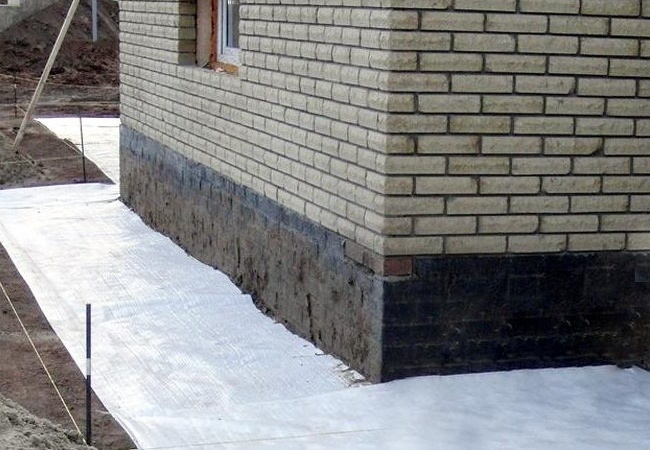
When installing the blind area, waterproofing and geotextiles are used, which prevent any penetration of water
For the blind area, you need to select a geotextile with the following properties:
- the density of geotextiles for construction work is desirable at least 150 g / m²;
- needle-punched fabric is recommended. It filters out water well and resists breaking loads;
- You can also choose thermally bonded textiles if there are no finely dispersed clay particles in the soil that clog the pores of the fabric.
For foundation
In the process of operation, the foundation experiences stresses from the forces of heaving of the soil and sags with insufficient bearing capacity of the soil. Using geotextiles allows you to cope with both problems, performing a reinforcing and separating function, so that the layers of sand and gravel do not mix with each other.
To strengthen the foundation, you should choose a geotextile with the following qualities:
- water-proof polypropylene textiles are ideal for work, woven fabric modifications do not have sufficient strength and are not used in construction;
- the density of the geo-cloth should be at least 350 g / m²;
- filtration properties will allow to drain water and extend the life of the foundation;
- for protection against groundwater, you can use thermofixed geotextiles - 200;
In order to properly equip the foundation with a layer of geotextile, lay the canvas on the bottom of the excavation dug under the base. At the same time, the area of the geo-fabric should exceed the area of the building under construction by at least a meter on each side. If necessary, the fabrics are sewn with a bag sewing machine. Rolls are rolled out and placed with an overlap of 50 cm, then the foundation is made using technology.
For beds
In the garden and in the garden, geotextiles are used to solve a number of pressing problems:
- Separation of various sections and layers of soil and soil. This helps preserve the fertile layer and does not mix fertilized soils with ordinary soil. With the arrangement of such a bed, we remove the top layer of soil, dig a pit under the future bed, line it with a geo-sheet, and fill up fertile fertilized soil and plant plants on top.
- Salvation of a garden from a weed. Dark-colored canvases that do not let in the sun's rays prevent the germination of weeds in the beds and clogging of the site. To solve this problem, we spread the canvas on the already loosened and prepared for planting soil surface, cut holes in the places of planting or sowing of plants;
- To prevent leaching of the fertile layer in areas with a slope or hilly terrain, a geotextile is placed on the surface in which windows are punched for the growth of shrubs and garden crops;
- To protect fruit trees, grapes, garden shrubs or from frost. Plants cover or wrap with a layer of geotissue.
- As a material for greenhouses and greenhouses. The geo-fabric perfectly passes water and air, at the same time shading plantings, and it serves much longer than the plastic film usually used for this.
The density of geotextiles for use on beds is desirable 150 g / m², it is recommended to choose a canvas of dark color with good moisture permeability.
Geotextiles have a lot of useful qualities and are widely used in various fields, an obstacle to its use can serve only as a lack of information about this innovative material. Having studied the properties and varieties of geotextiles, you can easily choose the right kind of canvas to solve various economic problems and get excellent results: a reliable foundation, beautiful paths at home and a beautiful crop in the garden.





